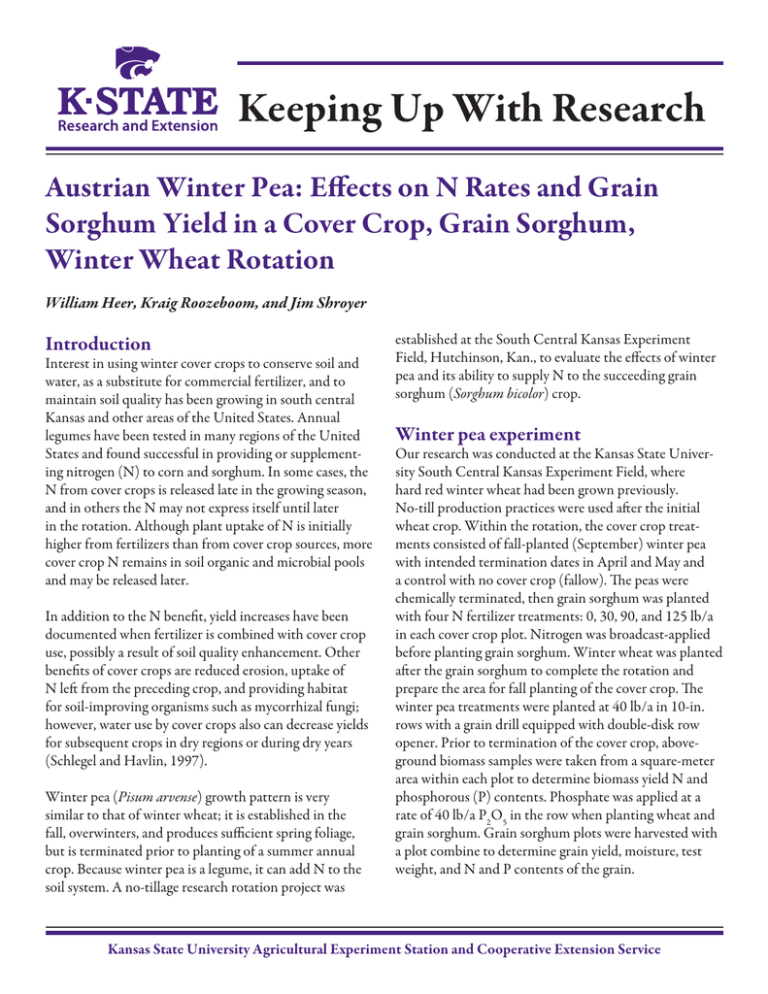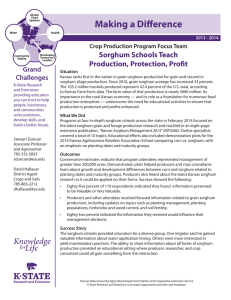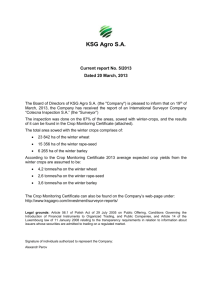
Keeping Up With Research
Austrian Winter Pea: Effects on N Rates and Grain
Sorghum Yield in a Cover Crop, Grain Sorghum,
Winter Wheat Rotation
William Heer, Kraig Roozeboom, and Jim Shroyer
Introduction
Interest in using winter cover crops to conserve soil and
water, as a substitute for commercial fertilizer, and to
maintain soil quality has been growing in south central
Kansas and other areas of the United States. Annual
legumes have been tested in many regions of the United
States and found successful in providing or supplementing nitrogen (N) to corn and sorghum. In some cases, the
N from cover crops is released late in the growing season,
and in others the N may not express itself until later
in the rotation. Although plant uptake of N is initially
higher from fertilizers than from cover crop sources, more
cover crop N remains in soil organic and microbial pools
and may be released later.
In addition to the N benefit, yield increases have been
documented when fertilizer is combined with cover crop
use, possibly a result of soil quality enhancement. Other
benefits of cover crops are reduced erosion, uptake of
N left from the preceding crop, and providing habitat
for soil-improving organisms such as mycorrhizal fungi;
however, water use by cover crops also can decrease yields
for subsequent crops in dry regions or during dry years
(Schlegel and Havlin, 1997).
Winter pea (Pisum arvense) growth pattern is very
similar to that of winter wheat; it is established in the
fall, overwinters, and produces sufficient spring foliage,
but is terminated prior to planting of a summer annual
crop. Because winter pea is a legume, it can add N to the
soil system. A no-tillage research rotation project was
established at the South Central Kansas Experiment
Field, Hutchinson, Kan., to evaluate the effects of winter
pea and its ability to supply N to the succeeding grain
sorghum (Sorghum bicolor) crop.
Winter pea experiment
Our research was conducted at the Kansas State University South Central Kansas Experiment Field, where
hard red winter wheat had been grown previously.
No-till production practices were used after the initial
wheat crop. Within the rotation, the cover crop treatments consisted of fall-planted (September) winter pea
with intended termination dates in April and May and
a control with no cover crop (fallow). The peas were
chemically terminated, then grain sorghum was planted
with four N fertilizer treatments: 0, 30, 90, and 125 lb/a
in each cover crop plot. Nitrogen was broadcast-applied
before planting grain sorghum. Winter wheat was planted
after the grain sorghum to complete the rotation and
prepare the area for fall planting of the cover crop. The
winter pea treatments were planted at 40 lb/a in 10-in.
rows with a grain drill equipped with double-disk row
opener. Prior to termination of the cover crop, aboveground biomass samples were taken from a square-meter
area within each plot to determine biomass yield N and
phosphorous (P) contents. Phosphate was applied at a
rate of 40 lb/a P2O5 in the row when planting wheat and
grain sorghum. Grain sorghum plots were harvested with
a plot combine to determine grain yield, moisture, test
weight, and N and P contents of the grain.
Kansas State University Agricultural Experiment Station and Cooperative Extension Service
Kansas State University Agricultural Experiment Station and Cooperative Extension Service
Winter pea and nitrogen
May termination was also delayed by wet conditions.
Weather conditions in 1999 were favorable for growth
of the winter pea. Winter pea aboveground biomass with
April termination was about half that of May termination in 1996; however, no significant differences were
measured in dry matter (DM) production between the
termination dates. Differences in the percentage N in the
DM existed only in the treatments for May termination.
Large amounts of N were not produced by the cover crop
in 1996; N credited to the cover crop based on biomass N
ranged from 9.48 to 30.70 lb N/a. The larger amounts of
DM produced in 1999 added considerable amounts of N
(Table 1).
Each component in the rotation was present every third
year, providing winter pea and grain sorghum yields
in 1996, 1999, 2002, 2005, and 2008. As the rotation
continued through the cropping sequence, the five-year
averages show the first increment of N resulted in the
greatest change in yield, and the yields tended to peak at
the 60 lb/a N rate treatment regardless of the presence or
lack of winter peas (Table 2). This same pattern is present
in the other rotations at the South Central Field where
grain sorghum is included in rotation with other crops
and N rates. The greatest five-year average increase in
grain sorghum yield was realized in the 90 lb/a N treatment where winter peas were terminated in May, which
suggests that the cover crop should be terminated early.
Grain sorghum yields
In 1996, the low levels of N from the peas did not translate into increased grain yield in the grain sorghum. Only
the no-N treatments with and without the cover crop and
the April termination with no cover crop and cover crop
plus 90 lb/a N treatments had significantly lower grain
yields (Table 2). Flag leaf N (%) and whole plant N (%)
were decreased in the no-N treatments with or without cover crop. The highest flag leaf and whole plant N
occurred in the April termination, 90 lb/a N treatment;
Soil conditions at planting of the winter peas in 1995
were excellent with good moisture. After planting,
temperatures cooled and limited fall growth of the peas.
Fall ground cover in 1996 ranged from 26 to 36% with no
significant differences across treatments compared with
36 to 46% in 1999 (Table 1). The winter months of 1996
were cool and dry, which limited growth and delayed
the April termination from early April to mid-May. The
Table 1.Winter pea cover crop and termination date effects on cover crop fall cover, dry matter (DM), and DM
nitrogen (N), South Central Field, Hutchinson.
Winter pea DM yield3
N from winter pea
Fall ground cover2
Termination
1
N rate
1996
1999
1996
1999
1996
1999
date
lb/a
------------ % ---------------------- lb/a --------------------- lb/a ----------4
April
0
33
46
302
3,061
9.48
103
30
28
36
413
2,796
12.43
94
60
30
36
342
2,895
10.26
83
90
36
40
717
3,317
22.68
109
5
May
0
36
40
900
4,590
19.71
128
30
34
39
1,200
4,674
32.4
148
60
33
41
1,110
4,769
23.98
139
90
26
43
1,279
3,850
30.7
100
6
LSD (P = 0.05)
NS
7
812
1,200
N applied as 34-0-0 after pea termination prior to planting grain sorghum.
Winter pea cover estimated by 6-in. intersects on one 44-ft line transect per plot.
3
Winter pea DM weight and percentage N and phosphorus determined from samples taken prior to termination.
4
April termination dates: May 16, 1996, and April 21, 1999.
5
May termination dates: June 4, 1996, and May 19, 1999.
6
Unless two yields in the same column differ by at least the least significant difference (LSD), little confidence can be had in one being greater than the
other. NS = not significant.
1
2
2
Nitrogen applied after winter pea termination prior to planting grain sorghum.
Early April termination. Actual termination May 16, 1996; April 21, 1999; April 13, 2002; and April 27, 2005.
3
Early May termination. Actual termination June 4, 1996; May 19, 1999; May 25, 2002; and May 18, 2005.
4
Unless two yields in the same column differ by at least the least significant difference (LSD), little confidence can be had in one being greater than the other. NS = not significant.
1
2
Keeping Up With Research
3
Table 2. Grain sorghum yield as affected by nitrogen (N) rate, winter pea cover crop, and termination date in a winter wheat-winter pea cover
crop-grain sorghum rotation, South Central Field, Hutchinson.
Flag leaf
Grain
1996
1996
1999
2002
2005
2008
Termination
N
1
N
P
N
P Yield
N
P
Yield
N
P Yield
N
P Yield
N
P Yield
date
rate
lb/a ----- % --------- % ----- bu/a
----- % ----- bu/a
----- % ----- bu/a
----- % ----- bu/a
----- % ----- bu/a
2
April, no pea
0
2.5 0.38
1.6 0.26 86.5
1.1 0.32 72.6
1.5 0.38 78.4
1
0.31 54
1.2 0.32 36
30
2.7 0.44
1.6 0.27 93.9
1.2 0.29 90.9
1.6 0.4 87.5
1.1 0.29 76
1.3 0.34 50.8
60
2.8 0.43
1.7 0.27 82.6
1.5 0.32 106.4
1.8 0.4 82.8
1.4 0.31 94
1.4 0.34 59.3
90
2.8 0.44
1.7 0.25 90.4
1.7 0.34 101.8
1.8 0.35 92.5
1.5 0.31 96
1.4 0.35 61.7
2
April, with pea
0
2.4 0.4
1.5 0.29 80.2
1.3 0.31 93.5
1.6 0.37 79.9
1.4 0.29 102
1.2 0.35 68.9
30
2.7 0.39
1.6 0.26 85.7
1.3 0.32 97.4
1.7 0.38 91.1
1.4 0.31 107
1.3 0.32 72.8
60
2.7 0.38
1.7 0.27 90
1.5 0.33 105.1
1.8 0.4 87.5
1.5 0.31 107
1.4 0.33 73.1
90
2.9 0.41
1.8 0.23 83.8
1.8 0.32 97.9
2
0.37 77.2
1.6 0.32 98
1.4 0.33 68.9
3
May, no pea
0
2.1 0.39
1.4 0.3 81.4
1.1 0.34 40.5
1.6 0.41 56.4
1.1 0.31 67
1.3 0.34 47.1
30
2.4 0.39
1.5 0.28 88.1
1.1 0.32 66.6
1.7 0.4 71.6
1.1 0.3
92
1.3 0.33 73.2
60
2.6 0.4
1.6 0.27 90.7
1.2 0.3
93.3
1.8 0.4 71.4
1.2 0.31 95
1.3 0.33 66.8
90
2.6 0.4
1.6 0.26 89.6
1.4 0.31 105.9
1.9 0.4 82.6
1.4 0.33 95
1.4 0.34 65.7
3
May, with pea
0
2.3 0.4
1.4 0.29 85
1.2 0.31 92.4
1.7 0.39 74.8
1.4 0.31 95
1.3 0.33 74.5
30
2.5 0.4
1.5 0.31 92.4
1.3 0.31 97.7
1.8 0.38 81.5
1.5 0.3
98
1.3 0.33 78.9
60
2.6 0.38
1.6 0.26 92.9
1.5 0.3 112.3
1.9 0.36 86.8
1.6 0.3
91
1.4 0.34 77.8
90
2.7 0.41
1.6 0.25 90.5
1.5 0.32 108.7
1.8 0.39 90.3
1.6 0.31 98
1.4 0.34 87.6
4
LSD (P = 0.05)
0.2 0.02
0.1 NS
8.9
0.2 0.04
16
0.14 0.05 14
0.11 0.02 15
0.1 0.03 24
Kansas State University Agricultural Experiment Station and Cooperative Extension Service
had peas and no additional N. This difference diminished
as the N rate increased and for the treatments where
the peas were terminated in May. As indicated by the
2008 data, as this rotation continues and the soil system
adjusts, the true effects of the winter cover crop in the
rotation will be revealed. In dry or normal years, precipitation during the growing season most likely will not be
as favorable as it was in 1999.
thus, the overall effect of the cover crop and N fertilizer
on flag leaf and whole plant N and grain yield in 1996
was not always significant or consistent. The increased
biomass N and the available water (above normal precipitation) during the 1999 growing season likely explains the
excellent grain sorghum yields (Table 2). The lowest yield
came from the treatment with no N and no cover crop
and the highest yield came from the 60 lb/a N with cover
crop (139 lb/a N in biomass) treatment. Grain sorghum
yields for 2002 reflect the later planting date (June 22).
The growing season in 2002 favored the later-planted
summer crops. They emerged after a June 15 hailstorm
and were not mature for an August windstorm, so they
had little lodging and stock damage, resulting in less
secondary tillering and fewer sucker heads than in other
years.
References
Schlegel, A.J., and J.L. Havlin. 1997. Green fallow for the
Central Great Plains. Agronomy Journal 89(5):762-767.
Acknowledgments
This project was partially funded by the USDA/SARE
program, and KSU College of Agriculture. Thanks to
Pioneer for providing grain sorghum seed for this project.
The 2008 yields (Table 2) express the presence of the
winter pea cover crop. The April termination, no peas,
and no N treatments yielded about half that of those that
Publications from Kansas State University are available at: www.ksre.
ksu.edu
Copyright 2011 Kansas State University Agricultural Experiment
Station and Cooperative Extension Service. Contents of this publication may be freely reproduced for educational purposes. All other
rights reserved. In each case, give credit to the author(s), Keeping Up
With Research, SRL 142, Kansas State University, September 2011.
Contribution no. 12-057-D from the Kansas Agricultural Experiment Station.
Kansas State University Agricultural Experiment
Station and Cooperative Extension Service
SRL 142
Brand names appearing in this publication are for product identification purposes only. No endorsement is intended, nor is criticism
implied of similar products not mentioned.
September 2011
K-State Research and Extension is an equal opportunity
provider and employer.
4






